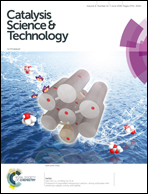Adjusting the ratio of bulk single-electron-trapped oxygen vacancies/surface oxygen vacancies in TiO2 for efficient photocatalytic hydrogen evolution
Abstract
The effect of the concentration ratio of bulk single-electron-trapped oxygen vacancies/surface oxygen vacancies on the photocatalytic hydrogen production of TiO2 was investigated. A series of TiO2 materials with a tunable concentration ratio of bulk and surface oxygen vacancies were prepared through a NaBH4 solid-state reduction method. The results of HRTEM, XPS, ESR, PL and UV-vis DRS verify that surface oxygen vacancies can form on the surface of TiO2 and the concentrations of bulk single-electron-trapped oxygen vacancies and surface oxygen vacancies increase with the increase of the reduction degree. Combining the evaluation of photocatalytic hydrogen production with the analysis of positron annihilation lifetime spectra, it is proved that the concentration ratio of bulk single-electron-trapped oxygen vacancies/surface oxygen vacancies plays the key role in the photocatalytic hydrogen production of TiO2, and the optimal ratio of bulk single-electron-trapped oxygen vacancies/surface oxygen vacancies leads to the best photoactivity.



 Please wait while we load your content...
Please wait while we load your content...